Nick Johnston names 10 guitarists who shaped his sound
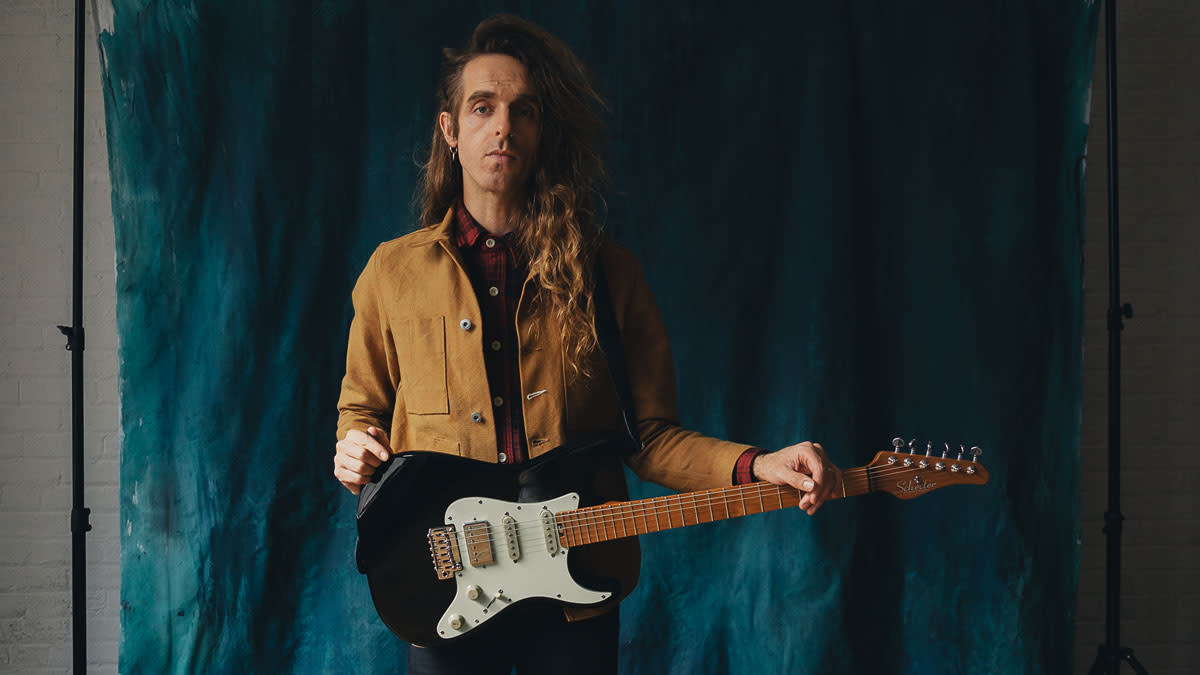
- Oops!Something went wrong.Please try again later.
Over the past decade or so, Canadian guitarist Nick Johnston has established himself as one of the most tasteful six-stringers of his generation.
On albums like 2014’s Atomic Mind and the Remarkably Human follow-up that arrived two years after, he took instrumental rock to new limits by mixing rolling legato techniques, sequenced arpeggios and outside scales into a sound that was very much his own – melting minds in ways not too dissimilar to Guthrie Govan, the man often labeled as the greatest player on earth.
The past few years, however, have seen Johnston trying new things and operating outside of the instrumental framework he’s typically associated with, starting with the launch of new band Archival with longtime friend Ben Ragan, which coincided with the introduction of his new Telecaster-style signatures through a longstanding relationship with Schecter.
And this year, he’s focusing on another new project called Osmanthus with wife Sachiko, who he married in 2021. This year, they released the single Diamond Tragedy – a mesmerizing four-and-a-half minute track that’s as atmospheric as it is infectious thanks to Nick’s stunning piano and guitar work coupled alongside Sachiko’s ethereal vocals. So how exactly did they meet, and when did they realize it was time to start making music together?
“I guess we met through music,” explains Sachiko, speaking to GW alongside Nick from their kitchen on Skype.
“I was recording some backing vocals on my brother-in-law’s music and Nick happened to see an Instagram story with me performing – we started talking because of that. After getting together and then eventually getting married, the conversation about starting our own project was a bit of a joke at first, to be honest! We were saying, ‘Imagine if we did this together… it would be like John and Yoko!’ But then it naturally evolved and we started doing it for real.”
“It was very natural,” agrees Nick. “I love music so much and anybody in my life that I become close to is usually because of music. To be in a position where I can be in a band with both my best friend and my wife is amazing.
“In this project I am purely the songwriter, while Sachiko does all the vocals and lyrics, which feels great. My role is just centered around writing interesting progressive rock alongside all the guitar solos I’m known for – using my red flame top nitro signature from the Schecter custom shop through a Boss SD-1 and a Friedman BE-100 – leaving it all on the table.
“I’ve never had a project like this before. Over the pandemic I spent so much time developing my keyboard playing, so it all kinda happened at the same time.”
When we point out the new track is a bit like hearing a mixture of Porcupine Tree and Pat Metheny, the couple look visibly pleased. Naturally, they’re going for their own unique sound, but clearly reference points like that are no bad thing at all. And, as it turns out, while preparing for this ‘10 guitarists who shaped my sound’ feature, Pat Metheny and Steven Wilson were both names that quickly to mind for Nick...
“It’s so funny,” grins Nick. “I had a list of players queued up for this interview and the top name was Pat Metheny and another was Steven Wilson! It’s crazy that’s what you hear. Those two musicians are incredible because they both have such broad catalogues... and they both like to write on piano! This new project is definitely in line with that tradition.
“We want to write the songs as composers and think about the guitar playing separately. That’s sorta new for me! But there’s still stuff like the opening note of my Diamond Tragedy solo that’s there to make the listener to feel a little uncomfortable. It might not be an obvious choice, but I was sat there thinking ‘Man, this feels good [laughs]!’”
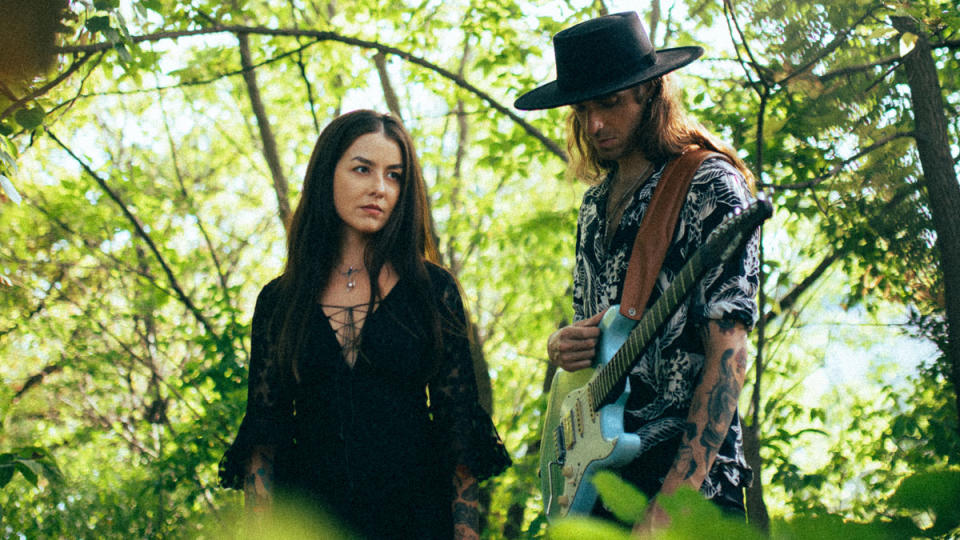
“My main vocal influences are all over the map,” adds Sachiko, when quizzed on her favorite singers. “The obvious ones would be Stevie Nicks and Lana Del Ray. But I also really love what Layne Staley did in Alice In Chains and, even though she’s way out of my vocal range, Elizabeth Fraser from Cocteau Twins. She has that really high symphonic voice with distinct vibrato.
“I love to see how different vocalists draw from different places to express themselves. Nick’s the same – one thing I noticed about him early on is that he has so many different influences in his playing. He’s not coming from just one genre – it’s not like he just listens to instrumental prog players; he takes from classical music, jazz and all sorts of things... and through that managed to create this really unique style.”
Which brings us rather nicely to the 10 guitarists who shaped Nick’s sound, with the man himself explaining what tracks and techniques inspired him to become the player he is today...
1. My Old Neighbor
“I have to give it up first and foremost to an old neighbor of mine called Frazer Azzoli, because he’s the one who actually got me into music. We still talk every so often and he’s still playing music in bands. But when I was 13, he moved in next door and was a year older. Back then, that age gap felt enormous! I kinda looked up to this guy.
“One day I walked over, knocked on his door and asked if I could come watch him play guitar because I could always hear it coming out of his bedroom window. I was so curious, wondering how exactly those noises were being made. So I sat down and watched his hand moving on the neck, and his other one strumming away.
“Even the way he unwrapped the curly cable and plugged it in made me think, ‘Holy shit!’ He showed me that if you hit a string and then hit it again moving your finger towards you, the sound would go up. That completely changed my life!”
2. Kirk Hammett
“When I was about 15 years old, I’d been playing for about a year and became wholeheartedly obsessed with Kirk Hammett. There was no question, he was my idol. I saved up all my money and bought the Cunning Stunts double VHS in eighth or ninth grade. I would watch it every single day without fail.
“He was so great and so dynamic, really different to what I’d heard before… which was mainly pop-punk. Blink-182, Sum 41 and all that stuff was the biggest music in the world when I was 13.
“Then I heard Master of Puppets and it completely rewired my brain. I guess it’s a bit like what kids are experiencing right now because of that [Stranger Things] TV Show. They’re blowing minds once again, right?!”
3. Yngwie Malmsteen
“So it’s like I was slowly leveling up, getting ready for the next guitar player, and the next one that came along who made me rethink not only the guitar but music in general was Yngwie Malmsteen. He made me want to study technique and understand theory, no question. He would have been the one where I had that classic moment where my jaw dropped.
“There was a song I discovered called Vengeance from his Magnum Opus record – I can’t remember how exactly but it was probably through the internet. I could have heard anything by Yngwie and it would have changed my life. But at the time, for some reason, that’s the song I first heard.
“It made me want to learn how to sweep pick and bend, as well as understand more about the harmony he was using. He would talk about harmonic minor, melodic minor and diminished arpeggios, so I went down this rabbit hole. I would take out books just to try and learn that theory.”
4. Pat Metheny
“The players we’ve talked about came into my life from my early teens to my later teens. And then right as I hit 18, someone recommended an album called Speaking of Now by Pat Metheny. I remember looking at the cover and thinking it was maybe a little boring, only because Yngwie’s Trilogy had a fuckin’ three-headed dragon [laughs]! Then this Pat Metheny album had pictures of the countryside and cornfields.
“But I put it on and that first song, As It Is, completely changed how I look at music. I was 18 then, and even now I’m still trying to live up to what happens in that song. The movement is stunning. That whole record is devastating – it almost made me want to give up. It’s also when I started to get more into piano. I didn’t know anything about composition, I had no idea. I only listened to young guitar players – at least on those classic early records – going really fast. And then Pat Metheny came along and within an instant I knew he was one of the true modern geniuses.
“Even records he was releasing 20 or 30 years into his career were taking the wind out of me. So that’s why in my late teens I really shifted my focus to piano and keys, trying to unlock that stuff. I found every time I learned something new and theoretical, I would apply it to the piano and that concept would keep widening. My universe would keep expanding. It was probably the moment I realized the more you know, the less you know!”
5. Biréli Lagrène
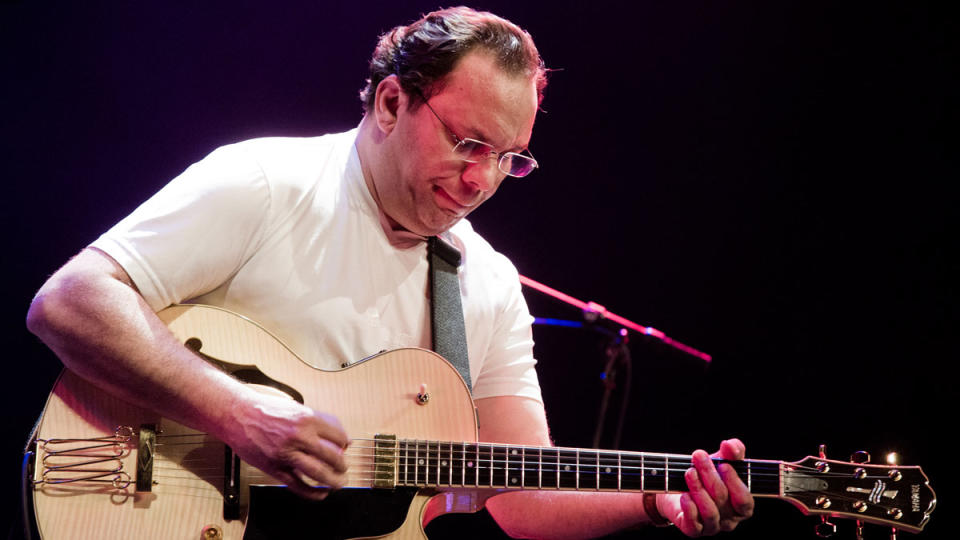
“When I was in my 20s, I started getting into players who were leaning into the jazz world a bit more, but keeping a lot of that bluesy and aggressive energy. That’s when I stumbled into the gypsy jazz players more – starting with Django Reinhardt and then moving onto Biréli Lagrène.
“The first time I heard him, it was similar to Pat Metheny in that it made me think ‘What is this? What am I hearing?!’ I couldn’t really play like that – I don’t have the right hand for it. But if you listen to that stuff, it will come out in your playing. All those half-step bends I do, that occasionally might sound like Marty Friedman, that all comes from that gypsy shit, man! It’s an almost whiney sound where you start quite dissonant and eventually bend into pitch.
“I was chasing the rhythmic aspect of that music, too. Even when they were playing over a straight beat, they would be swinging their 16th notes using a lot of chromaticism. If the chords were minor, they wouldn’t be scared of playing major scales over the top. You get this blind understanding of how tension works.
“There’s so much happening in that music, with arpeggios moving and re-harmonization, I almost don’t understand how much thought has gone into those songs. That level of guitar playing is incredibly rich. I don’t know where it came from, which is why I ended up becoming obsessed with it. It made me want to learn more about tritone substitutions and other ways to express myself.”
6. Jeff Beck
“Around this point, I took a little bit of a break from guitar. I didn’t know what the hell I was doing or what I wanted to play. I liked Mediterranean and gypsy music but I also loved Malmsteen and Metheny, so I was a bit confused about what I was trying to say. And that’s when I discovered Jeff Beck… which changed everything.
“He was this guy who could tie it all together with melody. He was obviously brilliant. It’s crazy to say he was at this point – rest in peace – it’s so sad. But he knew how to piece together all of his abilities. He used a Les Paul for a while but I really got to know him through his Stratocaster years. He would play with extremely unusual techniques but only applied to one or two notes. It could sound like a human being crying or a harmonica!
“That Live at Ronnie Scott’s footage is absurd. It’s easily one of the greatest performances in the history of guitar music. I don’t know what Jeff’s background was when it came down to music theory, I don’t particularly think it mattered. What I took from him is that melody is king and you can still be a blues guitar player even if you live in a world where there’s a jazz influence or some dark tension from the harmonic or melodic minor scales. He’d make it work through proper melodies. That was a big lesson for me!”
7. Mikael Åkerfeldt
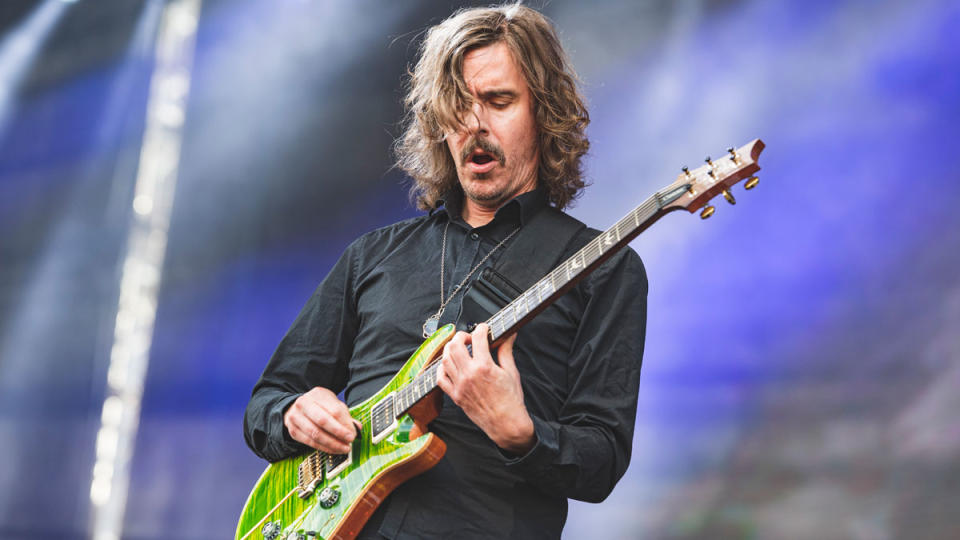
“After that, I started getting more into the modern progressive stuff, probably around my mid-20s. I liked a lot of the ’70s bands but I didn’t really know the guitar player’s names. I couldn’t tell you played in Camel or Eloy. I always loved the music, though! I got more and more into progressive music thanks to Opeth.
“I didn’t have the internet for most of my teen years so I didn’t discover this stuff until later than a lot of other people. But once I discovered Mikael Åkerfeldt I knew he was something really special.
“I love how bold he was, being a modern guy with a rabid metal fanbase, and then just telling everyone, ‘Yeah… I’m done with that!’ and coming out with Heritage. That was such a good album. It was authentic in every way, feeling and sounding great with this sense of bravery to it. I really love what Fredrik Åkesson has brought to the band, too – together they’re just out of control!”
8. John Southworth
“I was living in a town called Guelph in Ontario and I got dragged to this little venue that held around 50 people because a friend was playing. The guy supporting was called John Southworth. I wasn’t really expecting anything – I hadn’t heard of him and he was some older guy walking up to the mic to open the night. And it ended up being one of the most incredible and hypnotizing sets I’ve ever seen. I just stood there with my hairs on-end.
“There was no real technique or solos or anything like that. It was just straight-up brilliance. He put out a double record in 2014 called Niagara. I urge everyone to listen to it because it’s fuckin’ weird! I get a lot of my harmony from him. My songs don’t really sound like his but you can hear it in the chord movements, like where I might go from a Cmin to a C#, then a G followed by an F#min, but make sure I draw a straight line through it all. It’s that suspenseful non-diatonic thing… that’s my whole sound, I think!
“And he’s a local guy who lives in Toronto. Because of that one performance I saw, and I’m not shitting you, I ended up writing the entire Wide Eyes in the Dark record and most of Young Language, as well as a lot of the Archival stuff. That’s how much he blew my mind.”
9. Stevie Ray Vaughan
“My last two choices are fairly obvious for me, though I can’t remember exactly when SRV came into my life. But hearing stuff like Scuttle Buttin’ and even some of the more produced stuff, like that riff from Wall of Denial and Tightrope, really left an impression on me. He had this mega-deep ‘licktionary’, as I like to call it, which meant he never ran out of ideas or lose his flow.
“All of these guys are a big part of my musical DNA and when it comes to SRV, I have to say Riviera Paradise is one of my favorites because he was introducing more of a jazz feel. I’ve always wondered where he would have taken that. He also influenced me tonally, given that I mainly use single coils. Through him I learned you’ve got to keep your tone simple and make sure people can hear your hands. And things like 60-cycle hum and analog noises are good sounds a lot of the time.
“Guitars and amps can be very volatile pieces of technology but if you can harness them, holy shit, it can sound good. Even though he used a couple of pedals, he was one of those guys who was mainly about the tone of his hands on the strings coming out of his amp. I even tried playing in a blues trio for a while, purely because of him.”
10. Eddie Van Halen
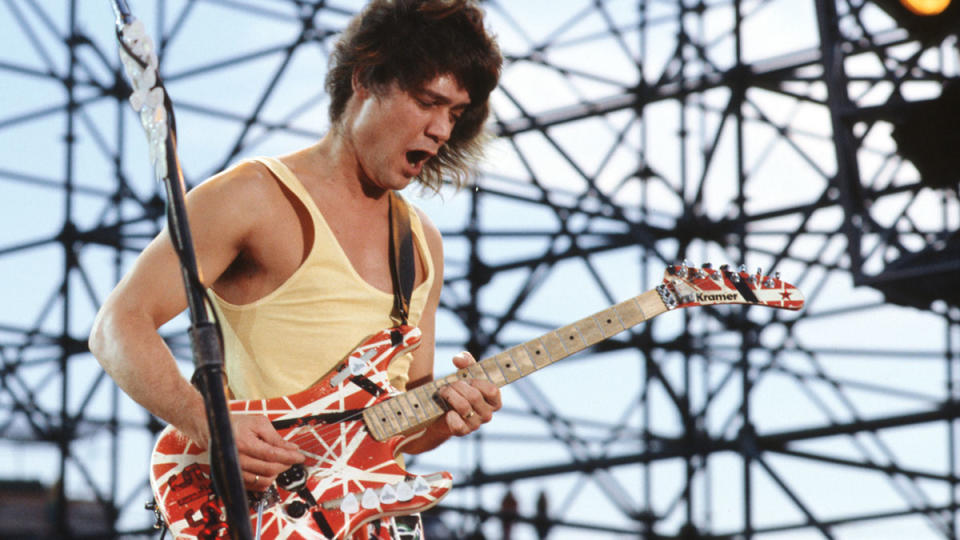
“It’s the weirdest thing, I’ve always felt like everyone, not even just guitar players, knows who Eddie Van Halen was. I discovered him through this television show called Animaniacs, which I watched when I was a kid. There was an animated Eddie Van Halen playing guitar in one of the episodes and I remember wondering who he was.
“Later on I found out it happened because he was on Warner Bros Records and the show was also made by Warner. My neighbor’s dad was also really into him, so I feel like Eddie’s always been there. My favorite Van Halen album? That’s an easy answer – I love all his playing on Van Halen II, specifically D.O.A. and Somebody Get Me a Doctor. I think it’s because those solos made no sense but they also made perfect sense [laughs].
“He was tapping into some primeval fuckin’ current… I don’t know what was going on. He knew things the rest of us didn’t. When I tried learning those solos I found them really hard. I couldn’t understand the intent or what he was thinking, wondering to myself, ‘Why would that work?!’ while also being able to appreciate that it always did!”

